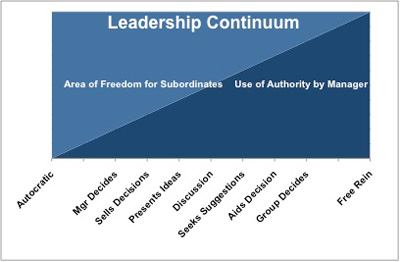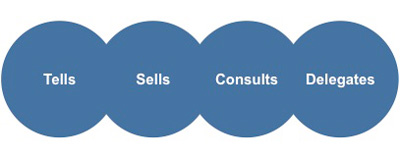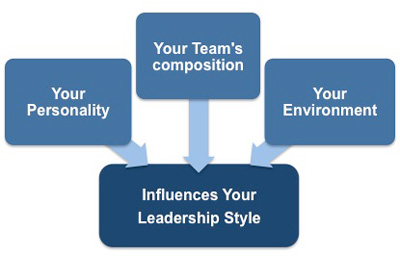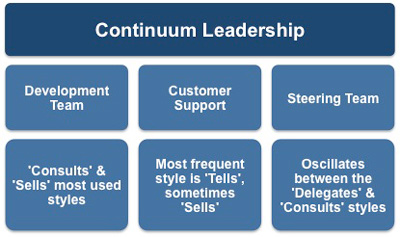The Leadership Continuum
The final approach you can use is to ensure that your leadership style arises out of the information you know about the task and members of your team. This approach is similar to Situational Leadership® in that it does not see leadership as a static state, but one that alters along a continuum so that your behavior best suits the situation you are dealing with.
In 1958 Tannenbaum and Schmidt wrote of the Leadership Continuum for the first time. It describes a continuum of possible leadership behavior available to you as a manager, along which many leadership styles may be placed. This offers you flexibility to adapt your leadership style to suit the situations you face every day at work.
 |
The continuum shows a range of actions that relate to the degree of authority used by the team leader and to the amount of freedom available to your members in arriving at decisions.
At one extreme there is 'autocratic,' often referred to as 'Boss-Centered' leadership, where you as manager would have total authority to make decisions and announce these to your team. This is unlikely to exist in your workplace because your decisions will frequently have to be made after consultation with senior management or shareholders, sometimes both.
As a manager or leader you are characterized according to the degree of control that you retain in the decision-making process. The four styles of leadership are known as 'Tells' (for the autocratic leader), then 'Sells', followed by 'Consults,' and finally 'Delegates.'
 |
You may work in an environment that requires you to resolve problems and inform your team of what they must do to address these problems without any consultation. In this instance you would be using the 'Tells' style of leadership within the continuum. Alternatively, your team may need to be persuaded by you to accept your decision before they will act. In this case you would adopt a 'Sells' style.
As the situation you work in evolves, your leadership style may move further along the continuum and you will be able to alter your style to that of 'Consults.' Your style becomes that of a facilitator: you present the problem to your team to resolve and the decision is jointly owned. The final style on the leadership continuum is known as 'Delegates.' This is where you define the framework your team works within to resolve a problem without interference.
The three factors that will help your decide which leadership style to adopt along the continuum are your own personality, the team itself, and the environment you are working in. Your own values, knowledge, and experience will influence your selection of a style.
The second factor affecting your chosen style will be the composition, character, distribution of skills, knowledge, and attitude of your members. You need to ask yourself whether or not your members are willing and able to accept responsibility for decision making. You will also need to assess how well they identify with and comprehend your organization's goals.
 |
The third and final factor is the environment you find yourself working in. This is made up of three aspects: the type and ethos of your organization, the nature of the problem you face, and the timescales within which it needs to be resolved.
According to the continuum theory, as leaders become more successful they learn to recognize and then portray the most appropriate behavior to suit the circumstances they face.
Applying this Style to the Team Examples
The most likely leadership style you would adopt along the continuum for each of our team examples would be:
Development Team
Your selected leadership style would be heavily dictated by the experience of your team. With a more experienced team you would be able to adopt a 'Consults' style where you present the problem and act as a facilitator in discussions to arrive at a jointly owned decision.
With a less experienced team you would adapt your style to 'Sells,' persuading your members to accept your decision using your more extensive experience to break down their resistance and hesitancy resulting from a lack of knowledge.
 |
Customer Support Team
As manager of this team you are most likely going to lead using a 'Tells' style. This is because you will identify a problem (often from reviewing the call statistics), come up with a solution, and then announce to your members what they need to do. Your members will not be involved in the decision-making process or the timescale.
At other times you may be able to adapt to a 'Sells' style where you persuade your team to accept your decision and act accordingly.
Steering Team
The nature and composition of your team allows you as manager to use a leadership style of 'Delegates.' The investigation of the Steering Team defines the parameters your team must work within, and you need to allow them to work within those limits without interference.
Often within this type of team you will have some sub-groups that require more guidance. In these instances you would adopt a 'Consults' style where you present the problem to your team and facilitate a shared solution.
Summary
Over the last 40 years, dozens of leadership theories have been published by academics or by management consultancies looking to create a proprietary leadership method from which they can then make money. As a result, there is a huge body of work available on leadership, much of which makes the claim that this is the latest approach, the most scientific approach, the most effective approach, and so on.
If you decide to study the available information on leadership, then you should do so knowing that most of what you read is simply a rehash of existing theories with some unique selling point or 'spin' grafted on in order to turn it into a method that can be sold.
In addition, most books on leadership can't resist the temptation to deal with this topic as if every manager really did have the potential to become the next Steve Jobs or Bill Gates. Whilst this might make for a thrilling read, it is usually quite difficult for you to apply any of the advice given unless you're on the board of directors or are working for a small organization where you really do have a lot of influence and authority.
For you as a manager, the most important aspect of your leadership is deciding how much freedom to give your team. Too much, and they may not achieve their targets, too little, and you will restrict their personal development and job satisfaction which can cause problems with motivation and productivity.
There is no easy answer to this problem and the best course of action is to consider each case on its merits with a clear appreciation of the risks involved of giving too much autonomy. This Team Leadership Checklist reminds you of the behaviors and attitudes that you need to be a successful leader.
You may also be interested in:
Team Leadership Theories | Leadership Theories and Management | Different Leadership Styles | Transactional Leadership | Transformational Leadership | Situational Leadership.



